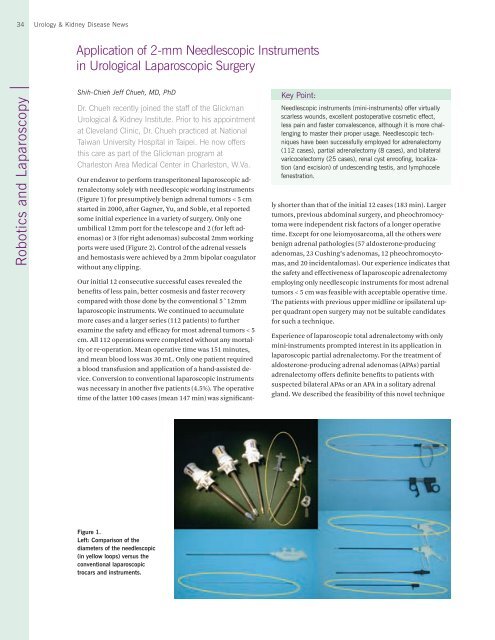Urology & Kidney Disease News Fall 2009 - Cleveland Clinic
Urology & Kidney Disease News Fall 2009 - Cleveland Clinic
Urology & Kidney Disease News Fall 2009 - Cleveland Clinic
Create successful ePaper yourself
Turn your PDF publications into a flip-book with our unique Google optimized e-Paper software.
34 <strong>Urology</strong> & <strong>Kidney</strong> <strong>Disease</strong> <strong>News</strong><br />
Robotics and Laparoscopy<br />
Application of 2-mm Needlescopic Instruments<br />
in Urological Laparoscopic Surgery<br />
Shih-Chieh Jeff Chueh, MD, PhD<br />
Dr. Chueh recently joined the staff of the Glickman<br />
Urological & <strong>Kidney</strong> Institute. Prior to his appointment<br />
at <strong>Cleveland</strong> <strong>Clinic</strong>, Dr. Chueh practiced at National<br />
Taiwan University Hospital in Taipei. He now offers<br />
this care as part of the Glickman program at<br />
Charleston Area Medical Center in Charleston, W.Va.<br />
Our endeavor to perform transperitoneal laparoscopic adrenalectomy<br />
solely with needlescopic working instruments<br />
(Figure 1) for presumptively benign adrenal tumors < 5 cm<br />
started in 2000, after Gagner, Yu, and Soble, et al reported<br />
some initial experience in a variety of surgery. Only one<br />
umbilical 12mm port for the telescope and 2 (for left adenomas)<br />
or 3 (for right adenomas) subcostal 2mm working<br />
ports were used (Figure 2). Control of the adrenal vessels<br />
and hemostasis were achieved by a 2mm bipolar coagulator<br />
without any clipping.<br />
Our initial 12 consecutive successful cases revealed the<br />
benefits of less pain, better cosmesis and faster recovery<br />
compared with those done by the conventional 5~12mm<br />
laparoscopic instruments. We continued to accumulate<br />
more cases and a larger series (112 patients) to further<br />
examine the safety and efficacy for most adrenal tumors < 5<br />
cm. All 112 operations were completed without any mortality<br />
or re-operation. Mean operative time was 151 minutes,<br />
and mean blood loss was 30 mL. Only one patient required<br />
a blood transfusion and application of a hand-assisted device.<br />
Conversion to conventional laparoscopic instruments<br />
was necessary in another five patients (4.5%). The operative<br />
time of the latter 100 cases (mean 147 min) was significant-<br />
Figure 1.<br />
Left: Comparison of the<br />
diameters of the needlescopic<br />
<br />
<br />
trocars and instruments.<br />
Key Point:<br />
<br />
scarless wounds, excellent postoperative cosmetic effect,<br />
less pain and faster convalescence, although it is more challenging<br />
to master their proper usage. Needlescopic techniques<br />
have been successfully employed for adrenalectomy<br />
<br />
-<br />
<br />
fenestration.<br />
ly shorter than that of the initial 12 cases (183 min). Larger<br />
tumors, previous abdominal surgery, and pheochromocytoma<br />
were independent risk factors of a longer operative<br />
time. Except for one leiomyosarcoma, all the others were<br />
benign adrenal pathologies (57 aldosterone-producing<br />
adenomas, 23 Cushing’s adenomas, 12 pheochromocytomas,<br />
and 20 incidentalomas). Our experience indicates that<br />
the safety and effectiveness of laparoscopic adrenalectomy<br />
employing only needlescopic instruments for most adrenal<br />
tumors < 5 cm was feasible with acceptable operative time.<br />
The patients with previous upper midline or ipsilateral upper<br />
quadrant open surgery may not be suitable candidates<br />
for such a technique.<br />
Experience of laparoscopic total adrenalectomy with only<br />
mini-instruments prompted interest in its application in<br />
laparoscopic partial adrenalectomy. For the treatment of<br />
aldosterone-producing adrenal adenomas (APAs) partial<br />
adrenalectomy offers definite benefits to patients with<br />
suspected bilateral APAs or an APA in a solitary adrenal<br />
gland. We described the feasibility of this novel technique
















